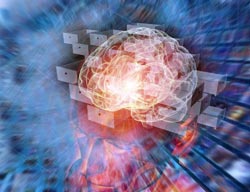How the brain forms categories

Forming categories is an advanced ability of the brain. Illustration: IMP<br>
How do we manage to recognize a friend’s face, regardless of the light conditions, the person’s hairstyle or make-up? Why do we always hear the same words, whether they are spoken by a man or woman, in a loud or soft voice?
It is due to the amazing skill of our brain to turn a wealth of sensory information into a number of defined categories and objects. The ability to create constants in a changing world feels natural and effortless to a human, but it is extremely difficult to train a computer to perform the task.
At the IMP in Vienna, neurobiologist Simon Rumpel and his post-doc Brice Bathellier have been able to show that certain properties of neuronal networks in the brain are responsible for the formation of categories. In experiments with mice, the researchers produced an array of sounds and monitored the activity of nerve cell-clusters in the auditory cortex. They found that groups of 50 to 100 neurons displayed only a limited number of different activity-patterns in response to the different sounds.
The scientists then selected two basis sounds that produced different response patterns and constructed linear mixtures from them. When the mixture ratio was varied continuously, the answer was not a continuous change in the activity patters of the nerve cells, but rather an abrupt transition. Such dynamic behavior is reminiscent of the behavior of artificial attractor-networks that have been suggested by computer scientists as a solution to the categorization problem.
The findings in the activity patters of neurons were backed up by behavioral experiments with mice. The animals were trained to discriminate between two sounds. They were then exposed to a third sound and their reaction was tracked. Whether the answer to the third tone was more like the reaction to the first or the second one, was used as an indicator of the similarity of perception. By looking at the activity patters in the auditory cortex, the scientists were able to predict the reaction of the mice.
The new findings that are published in the current issue of the journal Neuron, demonstrate that discrete network states provide a substrate for category formation in brain circuits. The authors suggest that the hierarchical structure of discrete representations might be essential for elaborate cognitive functions such as language processing.
The paper “Discrete neocortical dynamics predict behavioural categorization of sounds” by Brice Bathellier et al. was published in the journal Neuron on October 18, 2012.
About Simon Rumpel
Simon Rumpel was born in Erlangen (Germany) in 1972. He studied Biology at the University of Bochum and in 2001 received his PhD in Neurosciences. He then spent five years as a postdoc at Cold Spring Harbor Laboratory, New York, investigating the neuronal basis of memory. In 2006, Simon Rumpel joined the Research Institute of Molecular Pathology in Vienna as an independent group leader.
About the IMP
The Research Institute of Molecular Pathology (IMP) in Vienna is a basic biomedical research institute largely sponsored by Boehringer Ingelheim. With over 200 scientists from 30 nations, the IMP is committed to scientific discovery of fundamental molecular and cellular mechanisms underlying complex biological phenomena. Research areas include cell and molecular biology, neurobiology, disease mechanisms and computational biology. The IMP is a founding member of the Campus Vienna Biocenter.
Contact
Dr. Heidemarie Hurtl
IMP Communications
Tel.: (+43 1) 79730 3625
hurtl@imp.ac.at
Scientific Contact
rumpel@imp.ac.at
Media Contact
All latest news from the category: Life Sciences and Chemistry
Articles and reports from the Life Sciences and chemistry area deal with applied and basic research into modern biology, chemistry and human medicine.
Valuable information can be found on a range of life sciences fields including bacteriology, biochemistry, bionics, bioinformatics, biophysics, biotechnology, genetics, geobotany, human biology, marine biology, microbiology, molecular biology, cellular biology, zoology, bioinorganic chemistry, microchemistry and environmental chemistry.
Newest articles

Bringing bio-inspired robots to life
Nebraska researcher Eric Markvicka gets NSF CAREER Award to pursue manufacture of novel materials for soft robotics and stretchable electronics. Engineers are increasingly eager to develop robots that mimic the…

Bella moths use poison to attract mates
Scientists are closer to finding out how. Pyrrolizidine alkaloids are as bitter and toxic as they are hard to pronounce. They’re produced by several different types of plants and are…

AI tool creates ‘synthetic’ images of cells
…for enhanced microscopy analysis. Observing individual cells through microscopes can reveal a range of important cell biological phenomena that frequently play a role in human diseases, but the process of…





















